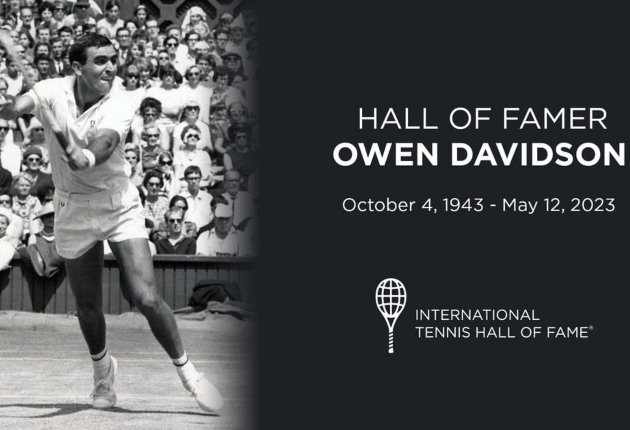
By ITHF Historian-At-Large Joel Drucker
Australian legend Owen Davidson, the most accomplished mixed doubles male player in tennis history, has passed away. Inducted into the International Tennis Hall of Fame in 2010, Davidson was 79 years old and had been a long-time resident of Texas at the time of his death.
To use Aussie lingo, the man nicknamed “Davo” was always regarded as a “first-rate mate.” Davidson maintained deep friendships with many people in all corners of the globe and across decades of tennis history. His crackling humor, warmth, and knowledge made him a keen source of wisdom for everyone, from corporate executives and agents, to journalists, television commentators, and fellow legends.
Gauff: GOAT Nadal RG Favorite Any Day
Crisp volleys, a superb overhead and a wickedly accurate lefty spin serve were Davidson’s trademark shots. In a career that lasted from the early ‘60s into the mid-‘70s, Davidson won 13 Grand Slam titles—eleven of them in mixed doubles and two in men’s doubles.
In 1967, Davidson became only the third player in tennis history to earn all four major mixed doubles titles in the same year. It started in Adelaide, Australia, when Davidson and compatriot Lesley Turner won their homeland major. The next three were earned with Davidson’s most frequent partner, Billie Jean King.
All told, the King-Davidson duo won eight majors (one French, four Wimbledon, three US). Arguably, the greatest King-Davidson effort came in the 1971 Wimbledon finals when they beat the formidable team of Margaret Court and Marty Riessen in an epic, 3-6, 6-2, 15-13. Said King, “We’d been out there a long time and at 13-all, I said to him, ‘Owen, let’s get out of here.’ And so we did. He was just terrific.”
Davidson also won the 1966 U.S. Nationals mixed doubles alongside Donna Floyd Fales and, in 1965, partnered with Robyn Ebbern, shared the Australian title with Court and John Newcombe (the final was not played due to inclement conditions).
As a men’s doubles player, Davidson earned two majors, winning the 1972 Australian Open with Ken Rosewall and joining forces with Newcombe to take the 1973 US Open. The latter was particularly pleasing for Davidson. “We played Laver and Rosewall – two of our heroes – in the final,” said Davidson. “It was amazing simply to be on the court with them.”
Davidson’s finest moment as a singles player came in 1966 at Wimbledon. In the quarterfinals, Davidson upset two-time defending champion Roy Emerson. Versus reigning U.S. Nationals champion Manuel Santana in the semis, Davidson fought valiantly, rallying from 1-5 down in the fifth set before losing the decider 7-5. He also reached the quarterfinals at seven other majors – five times at the Australian Championships, twice at the U.S. Nationals (precursor to the US Open).
On April 22, 1968, Davidson authored a distinct page of tennis history when he beat John Clifton in the first round of the British Hard Court Championships in Bournemouth—the first match of tennis’ Open Era.
Owen Davidson was born in Melbourne on October 4, 1943. In his formative years, Davidson was coached by another Hall of Famer, Mervyn Rose, a fellow lefthander long considered one of Australia’s premier tennis instructors. Later, as a member of the Australian Davis Cup team, Davidson worked closely with Davis Cup captain Harry Hopman.
Davidson spent the years 1967-’70 working for the British LTA. Davidson’s responsibilities there included being head pro at the All England Club, manager of British competitive tennis and coach of the British Davis Cup team.
During those years in England, Davidson wrote two books, Lawn Tennis: The Great Ones, Great Women Tennis Players and Tackle Lawn Tennis Way.
Davidson also held coaching positions at such prestigious venues as the John Newcombe Tennis Academy (near San Antonio), The Woodlands Country Club (Houston), and as COO of Grand Slam Sports Marketing, a partnership of former professional tennis players that created specialty tennis events for dozens of companies throughout the world.
Davidson took great pride in being a Hall of Famer, citing it high among the most meaningful accomplishments of his career.
Photo credit: International Tennis Hall of Fame